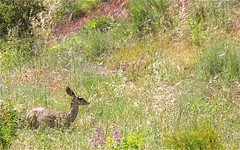An Artificial Obvious
One of the most asked questions along the Thompson Creek Trail is - “did you see the the deer?” To which, alas, I usually have to answer “no”.
I have seen quite a few deer in my lifetime. When I was in high school I spent a lot of time running through the hills and dales of Los Angeles's Griffith Park and saw them all the time, usually on the golf courses. It is kind of difficult to miss a good sized herd of large animals on a closely trimmed fairway. And, I did manage to see this one along the creek and photograph it.
Seeing them in the mountains is another story. This was painfully brought to my attention about forty years ago when a young woman of my acquaintance invited me to spend a weekend at her family’s cabin in Mineral King. One evening the two of us and another couple sat on the east-facing porch to watch the setting sun illuminate the west-facing slope across from us. The other three began seeing what must have amounted to dozens of deer. I never saw a one, much to my embarrassment.
Steward Edward White tells in The Mountains that deer can be invisible to the untrained eye even when they are standing in “plain sight. Seemingly, many people, like me, can look straight at them and not see them at all. White discusses what he calls creating “an artificial obvious” as the key to seeing deer.
I first came upon the phrase while reading Annie Dillard’s A Pilgrim at Tinker’s Creek. She did not shed much light on it as far as was concerned. But, now that i have gone to the source, I now understand that in a way we all view the natural world through a filter of sorts. This is to say that in any given situation we tend to see what we want to see and disregard the rest. Thus as I walk along the creek I first pay attention to the light as a photographer. Secondly I tend to notice plants, flowers, and birds based on my work at the botanic garden. Therefore, my eye tends to skip over the brown or gray splotches that would be deer. White, on the other hand, as a hunter will pass his eye over a slope and miss the flowering bush but see the buck which was hidden to me.
Holly seems to have constructed her own artificial obvious as well. Hers appears to be based on size. A lizard of say two to three inches is of no importance. A larger one is worthy of investigation. Her interest then ranges through birds such as towhees, squirrels, rabbits, cats, and other dogs. I find it noteworthy that she can spot a cottontail the same distance from us as the deer in the above photo and become excited. Yet, she exhibited no indication that the deer was there at all. Perhaps she feels that at her size large mammals are best ignored. If you pretend they are not there, they might not see you and just go away. While small reptiles and insects may be beneath her dignity. It occurs to that the little random bred's make-up is primarily terrier. Terriers were bred to pursue vermin such as rats and foxes. These certainly fall within the size of animals that attract her attention. So, Holly's artificial obvious could be genetic.
Do we all live in a world of our own design?
Saturday, July 3, 2010
On Seeing Deer
Labels:
animals,
Annie Dillard,
bird,
Claremont,
deer,
Holly,
lizard,
rabbit,
rambles,
squirrel,
Stewart Edward White,
Thompson Creek,
towhee
Subscribe to:
Posts (Atom)





